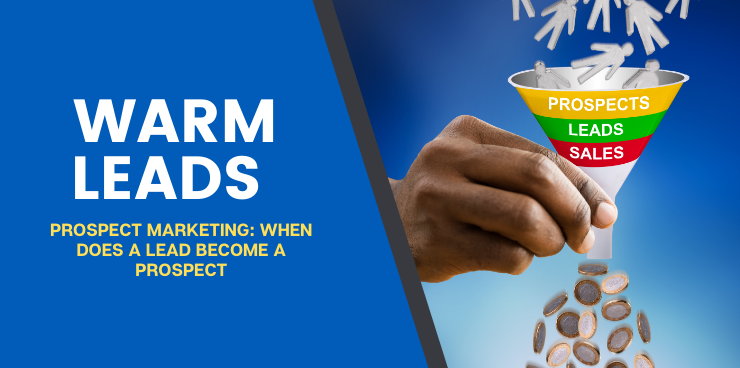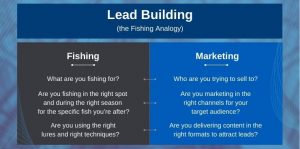Prospect Marketing: When Does a Lead Become a Prospect?
The terms “prospects’’ and “leads” are sometimes used interchangeably. After all, they are synonymous with one another, right? Actually, no. Keeping a separate definition of each will create a better understanding of the sales funnel. By discerning leads from prospects, you can adapt your sales strategies for greater effectiveness.
Lead generation, or lead building, remains a top priority for any growing business. However, separating those leads by interest level helps your sales teams prioritize their efforts. You can consider anyone who sees your advertisements a lead. However, only those interested can be considered prospects.
Think of your marketing efforts like fishing. Understanding the type of fish you want to catch helps you employ the right tactics to catch that fish. You want to use the right methods that appeal to that specific fish and you would not try to use a fake lure for a fish that only eats worms.
You can think of leads as all the fish in a body of water, and prospects as only the fish that bite. In this context, we’ll use an old fishing analogy to define exactly what we see as a “prospect” and where that falls in a funnel.
What Exactly is Prospect Marketing? When Does a Lead Become a Prospect?
Keeping your leads separate from your prospects allows you to narrow down your focal points. Categorizing the two depends on their interest and consideration in your product or service. Customer interest increases as they venture further down the marketing funnel. Leads sit above the funnel, having yet to enter. Prospects have entered the tunnel at the very top, expressing some sort of interest.
Referring back to the fishing analogy, a lead becomes a prospect when they take a nibble at your bait. Each fish in the river is a potential lead. So, you will cast your line to appeal to those who might be interested. The potential prospects are the ones who would actually care for the bait.
Prospect marketing is the bait that entices the fish to bite down, hooking them in the process.
Your sales teams need to tailor their sales approach depending on the prospect’s location within the sales funnel. Sorting out prospects from leads gives them a place to begin. By focusing their efforts only on the best opportunities, they do not waste time trying to attract someone who simply lacks interest.
By tailoring their sales approach, sales representatives engage in prospect marketing. They try to draw prospects further down the marketing funnel. The sales team cannot just give them the same content that garnered their attention in the first place. The presentation must change to foster that attention, turning it into consideration and then desire.
Inbound sales methods help your sales teams better understand the needs and wants of each prospect. Sales reps should take time to fully understand a prospect’s interests so that they can tailor a presentation. While they may take longer, inbound sales and other customer-oriented sales methods pay off tremendously.
To successfully perform prospect marketing, your business must focus on sales and marketing alignment. Your marketing materials get leads interested in your product, turning them from leads into prospects. Keep that momentum going by capitalizing on whatever caught their eye.
Therefore, your sales teams should work off of the promoted and marketed materials. When the marketing and sales approaches work in harmony, it tends to deliver more sales. Sales representatives should understand the impact of your business’s marketing efforts. This way, they can anticipate questions and respond thoughtfully.
Sales and marketing alignment also helps you pull leads deeper into the marketing funnel with less effort. You can use blog posts and other informative content to answer questions raised by your marketing materials. This way, your sales teams can come in and seal the deal, getting the most out of their efforts.
 A few Examples of Prospect Marketing
A few Examples of Prospect Marketing
Like most sales and marketing methods, prospect marketing takes several forms. The exact steps and techniques vary depending on the business. Always keep all marketing and sales efforts in line with your business’s goals.
Take inspiration from the following prospect marketing examples. You can pull from a few examples or create a mirroring method.
Whichever route you decide to go, stay open to experimentation. Adjust your efforts depending on your results to find the absolute best technique for your business.
White Papers
To kindle a prospect’s interest, you need to provide them with plenty of information. White papers accomplish exactly that.
White papers are a piece of long-form content acting as an in-depth report of a topic’s problems and solutions. Their larger size and digital presence make them comparable to ebooks.
A proper white paper provides plenty of opportunities to generate traffic and pull readers into the sales funnel. In a way, white papers act as sales presentations all within themselves.
Your business designs its products and services to solve an existing issue. By conveying how your products solve that issue, you generate interest and demand from your prospects. However, not every sales representative has the time to educate each and every prospect.
White papers allow your prospects to continue their education on a specific topic without interacting with a sales rep. Place white papers around your website and through email marketing campaigns for maximum exposure. When a customer clicks on an advertisement or blog post, the route links to your white papers to deliver additional information.
Like all sales techniques, white papers should work in harmony with your marketing content. Many marketing efforts raise some sort of concern or pique curiosity. Within your white papers, you have the opportunity to capitalize on this concern and/or curiosity.
When a prospect expresses interest, they require additional information before they make a purchase. White papers give them all the information they need. Additionally, white papers can offer product or service variants to better fit the prospect’s needs. The prospect will understand the product and its benefits more greatly. And when the benefits entice the prospect enough, consideration turns into desire.
White papers act as content marketing since they generate tons of website traffic through their use of keywords. They work wonders, turning a lead into a prospect and sending them right down the sales funnel.
Case Studies
Where white papers present straight facts and information about a topic, case studies act as the source. Earning the trust of your prospects and leads takes time. You need to handle the issue delicately. Once a lead’s trust breaks, it rarely comes back
Case studies help you gain and secure that trust. They can include research, trial results or any other kind of corroborating statements. Whatever they examine, case studies need to present definite and concrete evidence that your product provides a solution for.
You can use a series of specific case studies to present a string of evidence in favor of your product. This way, you demonstrate that the benefits are not outliers, but a repeatable result.
To make sure that a case study works its magic, prospective customers need to understand them. Refrain from using technical jargon and always explain any ambiguous terms. Keep all information relevant to your product so that the customer does not lose interest.
You can deliver case studies through a variety of formats, including articles and videos. Use infographics to help spice up whichever format you choose. They capitalize on reinforcing the most important information presented in your case study.
Using real examples of your product’s success in customers’ lives gives prospects the confidence to make a purchase.
Email Marketing
Many companies use email marketing as a simple but effective way to continually reach prospects. When a customer gives their contact information, they usually have some degree of interest. Email marketing constantly reminds them of your product and gradually pushes prospects down the funnel towards a sale.
Your business can send emails to either new or existing customers. Many companies use website pop-ups as a popular way to capture a lead’s contact information. By simply sending out a mass newsletter to each prospective customer, you can foster interest and consideration.
Many prospects may wish to wait until a deal or special offer before making a purchase. With an emailed newsletter, you can keep them up to date regarding all current offers. You can also generate excitement regarding new releases and product updates.
However, many emails tend to end up right in the trash or spam folder. Use enticing copy and relevant information to keep your emails always in the active inboxes.
Emails give you an excellent opportunity to continue engaging with existing customers. Instead of letting them go after a purchase, you can maintain contact. Hopefully, existing customers will continue returning for additional purchases.
Adjust your emails so that they are tailor-made for each market segment you wish to appeal to. For instance, try dividing email lists based on demographics or specific products. This helps create a neater target zone so that your emails have a more specific appeal.
No matter the content, emails should contain links back to your website or online store to facilitate purchases. Remember to keep emails in line with your overall marketing strategy. All included links should direct to content or web pages relevant to the email topic.
 Summary
Summary
You can use these prospect marketing methods alone or in combination with each other. Play around with different techniques to find the match that works best for you. Whichever way you decide to go, remember these two factors to keep your prospect marketing successful:
1. Keep Prospects Engaged With Your Brand
Remember that you need to strive towards a specific goal with your marketing efforts. Keep all content and materials related to the specific topic you are focusing on.
The more engaging a piece of content, the more likely a prospect will return or dig deeper. Prospect marketing content should retain the prospect’s focus and interest regarding your business. Keep the most enticing content and cut out any filler.
Sometimes, a prospect might not purchase during their first few visitors or interactions. When they keep coming back for more, it increases the chances they’ll make an eventual purchase. If you focus on creating engaging content, the attraction will grow.
2. Pull Prospects Deeper Into the Sales Funnel
All prospect marketing materials should continue developing and adding to a prospect’s interest in your product. Keep focusing on highlighting the benefits of your product with each piece of content. This will generate interest in new prospects and reignite it in returning prospects.
Each piece of content should give its audience a new reason to make a purchase from you. Whenever a prospect gets stuck in one stage of the funnel, deliver a new format to break up the monotony. Keeping it fresh will prevent you from losing out on their business.
All content regardless of its format should be well-crafted. Use enticing copy for written formats and interesting visuals for videos. Take advantage of all the tools in your arsenal to create an irresistible marketing campaign.
Forge Ahead With Confidence
No matter your business needs, Selling Revolution can help you create a lasting and impactful marketing strategy. From lead generation to sales training, we give your business the keys to success. How far you want to take it is up to you.
To start on your journey towards a more potent marketing campaign, schedule a 20-minute introductory call today.




 A few Examples of Prospect Marketing
A few Examples of Prospect Marketing Summary
Summary